
Security Issues May Hurt Development in Latin America
Story Highlights
- Latin America ranks as least safe region for sixth year in a row
- Liberians, Venezuelans least secure worldwide
- Singapore tops "secure" list for second year
WASHINGTON, D.C. -- Meeting the targets of the United Nations' new Sustainable Development Goal of "promoting peaceful and inclusive societies" will be difficult in many parts of the world, but particularly so in Latin America and the Caribbean. For the sixth consecutive year, Gallup's Law and Order Index shows that residents of Latin America and the Caribbean in 2014 were the least likely in the world to feel secure in their communities.
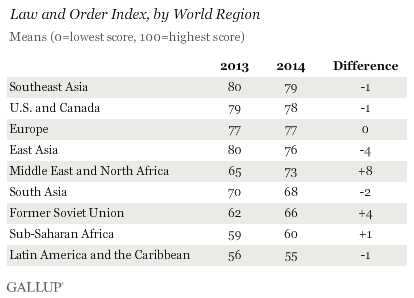
Last year, Latin America and the Caribbean scored a 55 (on a scale from 0 to 100) on Gallup's Law and Order Index, which is based on people's confidence in their local police, feelings of personal safety and self-reported incidence of theft. Gallup compiles the "positive" responses to these three questions into a Law and Order Index score for each country. The higher the score, the higher the proportion of the population that reports feeling safe. Lower scores also suggest conditions and public perceptions that could hurt development. Additional Gallup research reveals strong relationships between people's answers to these questions and external measures related to economic and social development.
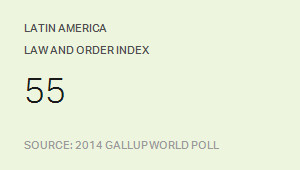
Given the region's average homicide rate, which has been higher than that of any other region for the past decade, it's not surprising that the poor personal security situation in Latin America and the Caribbean has changed little over the past several years. In 2014, all countries in the region had index scores below the global average of 69. Chile, which has generally lower crime rates, came the closest, with an index score of 68.
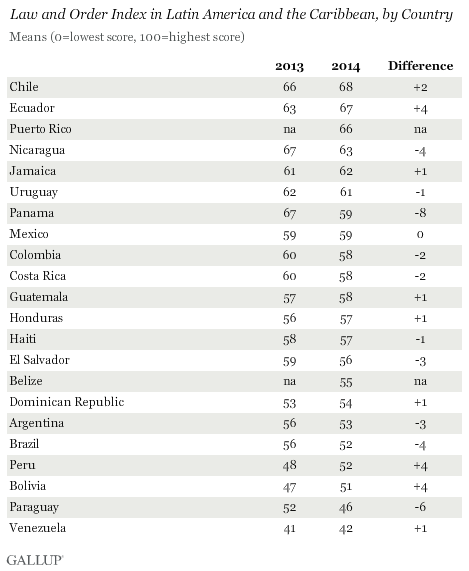
Venezuela's index score of 42 was the worst in Latin America and the Caribbean in 2014, and nearly the worst in the world. Only Liberians, who were surveyed at the onset of the 2014 Ebola outbreak, scored lower, with an index of 40. However, the 22% of Venezuelan adults who said they felt safe walking alone at night was notably the lowest in the world. The economically troubled country, which has the second-highest murder rate in the world after Honduras, has ranked at or near the bottom of the "least safe" list since 2009.
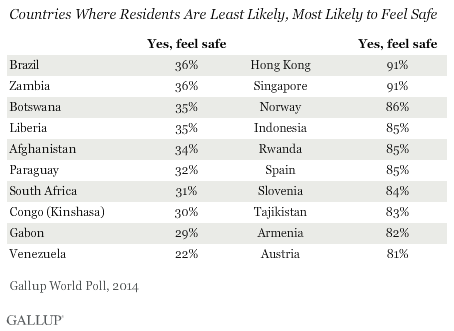
The countries where residents were the most likely to say they feel safe walking alone at night are among those with the highest Law and Order Index scores in the world. In Singapore and Hong Kong, with index scores of 89 and 87, respectively, more than nine in 10 residents (91%) said they felt safe. Singapore also led the world on the Law and Order measure in 2013.
Egyptian Confidence Post-Election Boosts Regional Average
The Law and Order Index score for the Middle East and North Africa improved the most between 2013 and 2014, rising from 65 to 73. However, this increase is largely attributable to a 24-point surge in Egypt's score shortly after President Abdel-Fattah el-Sissi took office and the absence of 2014 data from war-torn Syria. Relatively low scores in both of these countries depressed the region's index score in 2013.
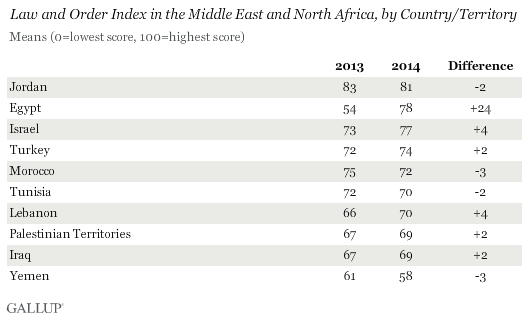
With a score of 58, Yemen was the only country in the region with a Law and Order Index score lower than the global average. Faith in the country's security was declining in Yemen in 2014 ahead of the Houthi rebels' seizure of the capital of Sanaa in September 2014.
Implications
High crime rates can suppress social cohesion and negatively affect economic performance. Given the United Nations' inclusion of reducing all forms of violence and related deaths as part of the world's development goals post-2015, indicators such as Gallup's Law and Order Index will be important to continue to monitor. This is particularly true in places such as Latin America, where there has been progress in other areas of development, including poverty reduction.
Get the full results for the world in the Global Law and Order 2015 report.
The data for each component of the Law and Order Index are available in Gallup Analytics.
Survey Methods
Results for surveys in 2014 are based on telephone and face-to-face interviews with approximately 1,000 adults, aged 15 and older, conducted throughout 2014 in 141 countries. For results based on the total sample of national adults, the margin of sampling error ranged from ±2.1 percentage points to ±5.6 percentage points at the 95% confidence level. All reported margins of sampling error include computed design effects for weighting.
For more complete methodology and specific survey dates, please review Gallup's Country Data Set details.
